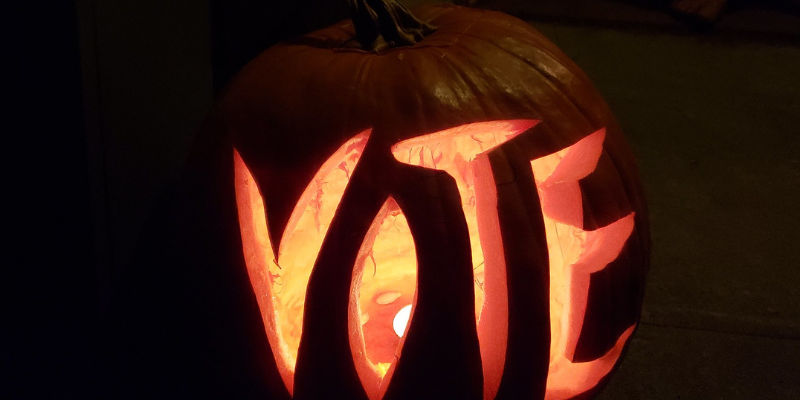
A couple weeks ago, I wrote about why Donald Trump should love automatic voter registration. The upshot: Automatic voter registration increases turnout by a few percentage points but does not, as Trump fears, help Democrats win elections. In general, increasing turnout often does not change the balance of Democrats and Republicans in the electorate.
But the conventional wisdom – that higher turnout helps Democrats – persists, in Trump’s mind and elsewhere. Now, a new study suggests that the conventional wisdom needs updating.
The study, just published in American Politics Research and authored by political scientists Spencer Goidel, Thiago Moreira, and Brenna Amstrong, begins with the well-known “diploma divide” in the U.S. electorate, whereby white voters with more formal education have been shifting toward the Democratic party while white voters with less formal education have been shifting toward the GOP.
Of course, people with more formal education are also more likely to turn out and vote. Thus, habitual voters might now be more Democratic-leaning, and people who vote less frequently more Republican-leaning. If higher turnout means that more infrequent voters actually vote, then the authors quite reasonably ask: Could the diploma divide mean that higher turnout actually benefits … Republicans?
Goidel, Moreira, and Armstrong investigate this by examining how higher turnout could have affected Democratic vote share in the 2010 to 2020 elections. Building on a technique employed by political scientists Michael Martinez and Jeff Gill, the authors of the new paper use statistical models to estimate the probability that people vote as well as the probability that, when they vote, they vote Democratic or Republican.
They then simulate higher and lower turnout levels by adding or dropping voters based on their predicted probability of turning out. For example, to “raise” turnout by 5 percentage points, you’d take people who didn’t vote and “add” the ones with the highest chance of voting to the electorate until the turnout rate is 5 points higher. Based on these new voters’ predicted chance of voting Democratic or Republican, you can estimate how much this 5-point increase in turnout helped or hurt either party.
A key finding: Increases in turnout no longer increase Democratic vote share very much. For example, here’s what they write about the estimated impact of increasing turnout by 15 points over the actual level in each of the six elections:
A 15% increase in turnout would have led to a 1.5% increase in Democratic votes in 2010, a 1.0% increase in 2012, a .7% increase in 2014, a .3% increase in 2016, a .2% increase in 2018, and a .4% increase in 2020.
In other words, in 2016 and 2020, when the diploma divide widens, Democrats are no longer helped much by increased turnout.
What about when you drop turnout by 15 points? The estimated effect is a -6.1 point decrease in Democratic vote share in 2010, -1.8 point decrease in 2012, a -2.7 point decrease in 2014, a -2.6 point decrease in 2016, a -0.2 point decrease in 2018, and a -1.1 decrease in 2020. This also suggests a more muted effect in more recent elections.
Goidel, Moreira, and Armstrong go on to show how the “marginal abstainer” – the 15% of nonvoters with the highest predicted probability of voting – has become slightly more likely to be Republican than Democratic:
In 2010, marginal abstainers are substantially more Democratic than voters – 7.2%. The gap in Democratic identification between voters and marginal abstainers shrinks until 2018 when the relationship reverses. In 2018 and 2020, the voters are .5 and .2% more Democratic than the marginal abstainers.
If higher turnout means pulling more of these marginal abstainers into the electorate, then the partisan balance may not shift in Democrats’ favor. Indeed, it could be basically a wash and even slightly beneficial to Republicans.
Of course, simulating the effects of higher or lower turnout is just that: a simulation. It’s predicated on assumptions about, for example, which nonvoters would vote and how nonvoters would vote. Those sorts of assumptions are inevitable in the research on this topic, including three different studies I’ve co-authored. Back in 2015, I wrote two blog posts that tried to summarize this literature and its various methodological decisions and trade-offs.
But even acknowledging the challenges of simulating a hypothetical, there’s still an important implication here. Goidel, Moreira, and Armstrong’s evidence points to the possibility of changing the debate about electoral laws. For years, the conventional wisdom has been that making voting easier helps Democrats and hurts Republicans. But if even 15-point shifts in turnout don’t produce big shifts in vote share – and most changes in turnout, whether induced by policies like automatic voter registration or by the buzz of a particular election, are smaller – then Republicans in particular have little reason to oppose reforms that make voting easier.
Increasing turnout at the margins may not benefit either party very much, if at all.



